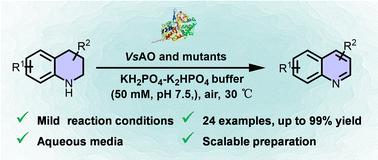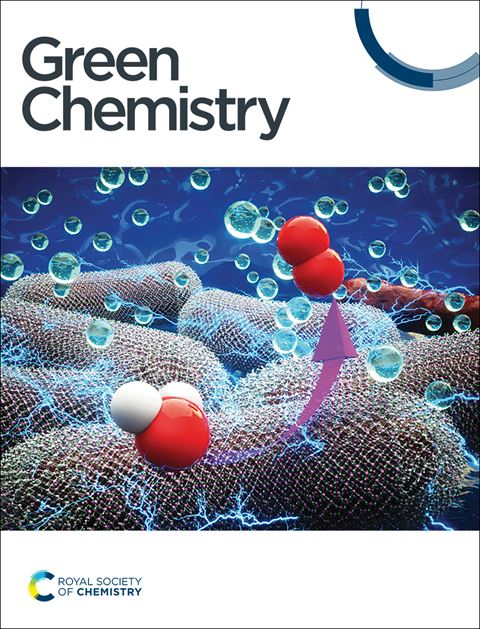Engineered amine oxidase for efficient oxidative dehydroaromatization of 1,2,3,4-tetrahydroquinolines toward quinolines in aqueous media†
IF 9.2
1区 化学
Q1 CHEMISTRY, MULTIDISCIPLINARY
引用次数: 0
Abstract
The oxidative dehydroaromatization (ODA) of 1,2,3,4-tetrahydroquinoline (THQ) is a highly atom economic route for the synthesis of quinoline, a privileged N-heterocyclic motif in the pharmaceutical industry, while requiring stoichiometric strong oxidants and noble metal catalysts. Amine oxidase (AO)-catalyzed oxidative dehydroaromatization of THQs is a sustainable alternative but still suffers from low activity and a narrow substrate scope. Herein, a novel amine oxidase from Vibrio sp. JCM 19236 (VsAO) was obtained by gene mining and its mutant M2(F368D/N127K) was obtained by protein engineering. VsAO exhibited higher ODA activity over the reported AOs due to the unique dual-tunnel structure for substrates/products entrance/exit. M2 exhibited higher enzyme activity owing to the narrowed port and enhanced positivity at the tunnel that is close to the isoalloxazine ring head of flavin adenine dinucleotide (FAD), pushing the substrate closer to the isoalloxazine catalytic center of FAD and leading to higher enzymatic activity and higher catalytic performance.

用于在水介质中将 1,2,3,4-四氢喹啉向喹啉类高效氧化脱氢芳香化的工程胺氧化酶†
1,2,3,4-四氢喹啉(THQ)的氧化脱氢芳构化(ODA)是合成喹啉的一种高度原子经济的途径,喹啉是制药工业中具有优势的n -杂环基序,但需要化学计量的强氧化剂和贵金属催化剂。胺氧化酶(AO)催化四氢酚氧化脱氢芳构化是一种可持续的替代方法,但仍然存在活性低和底物范围窄的缺点。通过基因挖掘获得了一种新的Vibrio sp. JCM 19236 (VsAO)胺氧化酶,并通过蛋白工程获得了其突变体M2(F368D/N127K)。由于独特的底物/产物入口/出口双通道结构,VsAO比报道的AOs表现出更高的ODA活性。M2由于靠近黄嘌呤二核苷酸(FAD)的异alloxazine环头的通道处的孔口变窄和正性增强,使底物更靠近FAD的异alloxazine催化中心,从而具有更高的酶活性和催化性能。
本文章由计算机程序翻译,如有差异,请以英文原文为准。
求助全文
约1分钟内获得全文
求助全文
来源期刊

Green Chemistry
化学-化学综合
CiteScore
16.10
自引率
7.10%
发文量
677
审稿时长
1.4 months
期刊介绍:
Green Chemistry is a journal that provides a unique forum for the publication of innovative research on the development of alternative green and sustainable technologies. The scope of Green Chemistry is based on the definition proposed by Anastas and Warner (Green Chemistry: Theory and Practice, P T Anastas and J C Warner, Oxford University Press, Oxford, 1998), which defines green chemistry as the utilisation of a set of principles that reduces or eliminates the use or generation of hazardous substances in the design, manufacture and application of chemical products. Green Chemistry aims to reduce the environmental impact of the chemical enterprise by developing a technology base that is inherently non-toxic to living things and the environment. The journal welcomes submissions on all aspects of research relating to this endeavor and publishes original and significant cutting-edge research that is likely to be of wide general appeal. For a work to be published, it must present a significant advance in green chemistry, including a comparison with existing methods and a demonstration of advantages over those methods.
 求助内容:
求助内容: 应助结果提醒方式:
应助结果提醒方式:


